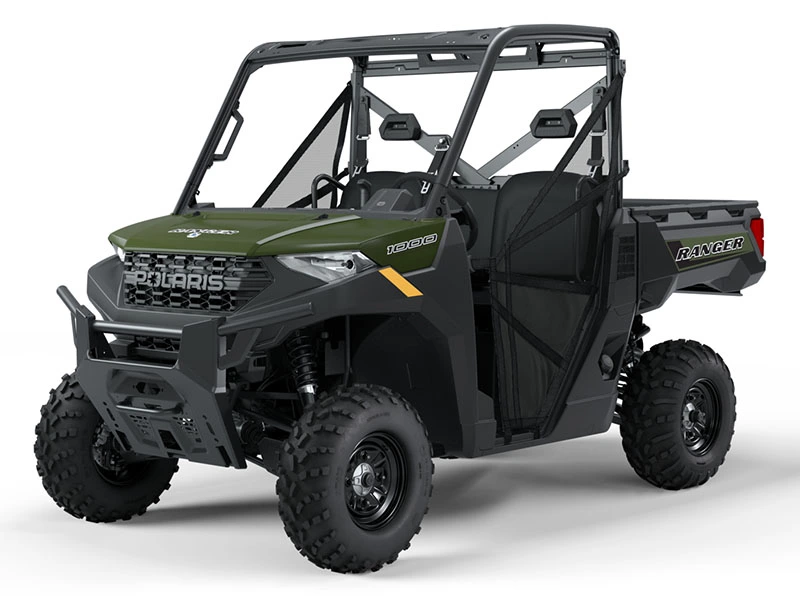Bottom line
- Ranger 1000 Standard (25″ stock): Safe no-rub = 28×10R14 all around on 14×7 4+3 wheels. On factory 12s, stay 26–27 in.
- Ranger 1000 Premium (26″ stock): Safe no-rub = 28×10R14 all around on 14×7 4+3.
- Ranger XP 1000 (29″ stock): Stay 29×9-14 / 29×11-14 or step to 30×10R14 or 30×10R15 with 14×7 4+3 or 15×7 5+2. Test lock-to-lock.
Ranger 1000: tires that fit without rubbing

| Trim / Year | Stock wheel & tire (F/R) | Bolt pattern | Stock wheel width & offset (F/R) | Max tire that clears, stock suspension* | Wheel offset / backspacing that works | Speed change vs stock (@60 mph) | Notes (full lock / compression) | Sources |
|---|---|---|---|---|---|---|---|---|
| Ranger 1000 Standard (2025) | 25×10-12 F / 25×11-12 R | 4/156 | 12×? (offset not published) | 28×10R14 all around on stock suspension (wheel upgrade to 14″ required). (owners report) | 14×7 4+3 is the common “no-rub” pick on stock height. | +12% (~+7.2 mph) from 25→28 | Check inner tie-rod boot and fender liner at full lock. | Polaris owner’s manual tires (Std 25″), bolt pattern via Polaris Q&A; owner fit threads. (publications.polaris.com) |
| Ranger 1000 Premium (2025) | 26×9-12 F / 26×11-12 R | 4/156 | 12×? (offset not published) | 28×10R14 all around on stock suspension. (owners report) | 14×7 4+3 keeps inner clearance, widens ~2 in. | +7.7% (~+4.6 mph) from 26→28 | Watch inner A-arm and brake line at full stuff. | Polaris specs (26″), bolt pattern, owner offset math. (Polaris) |
| Ranger XP 1000 Premium / NorthStar (2025) | 29×9-14 F / 29×11-14 R (Pro Armor X-Terrain) | 4/156 | 14×6 ≈ +26 mm F / 14×8 ≈ +31 mm R (owner measured) | 30×10R14 workable with the right offset; slight contact possible at full lock on some trims. (owners report) | 14×7 4+3 or 15×7 5+2 are the common no-rub choices; recheck toe. | +3.4% (~+2.1 mph) from 29→30 | If you see nibble at full lock, add a hair of preload or bump steer stops. | Polaris manual/specs (29″), owner-measured stock offsets, owner fit threads showing 30s. (publications.polaris.com) |
- “Max tire that clears” entries are owner-reported on stock suspension and body, no trimming, typical loads. Always test at full lock and near-full compression before committing.
Why these picks: Polaris lists the stock sizes (25″ Std, 26″ Premium, 29″ XP) for 2025. That’s our baseline. The 4/156 bolt pattern is confirmed in Polaris’ accessory Q&A.
Typical stock XP wheel offsets are ~+26 mm (14×6 F) and ~+31 mm (14×8 R) per owner measurements, which is why a 14×7 4+3 aftermarket wheel often clears inner components while widening track only modestly.
Owner threads consistently show 28×10 as the clean “no-rub” upsize on base/Premium, and 30×10 as doable on XP with the right offset and a careful lock-to-lock check.
Quick answer — what fits without rubbing
- Ranger 1000 (2020–2025): 28×10R14 all around on 14×7 4+3 wheels works for most of us on stock suspension. Test at full lock and near-full compression. (owners report)
- Ranger XP 1000 (2025): Comes on 29s from the factory. 28×10 is easy. 30×10R14 or 30×10R15 can work with 14×7 4+3 or 15×7 5+2. Some tires may kiss at full lock. (owners report)
- Arched A-arms (Trail Boss): More clearance at the arms. Helps with larger tires on stock height.
Stock sizes and hardware (know your baseline)
- Ranger 1000 Standard (2025): 25×10-12 F / 25×11-12 R.
- Premium (2025): 26×9-12 F / 26×11-12 R. These are the sizes I start from when I do the math.
- Ranger XP 1000 (2025): 29×9-14 F / 29×11-14 R Pro Armor X-Terrain on aluminum wheels. That’s why 30s are the next natural step.
- Bolt pattern (full-size Ranger): 4/156. Owner docs and fitment threads confirm it across years; check stud size per year.
- Typical stock XP wheel widths/offsets (for math): Front 14×6 ~+26 mm (≈4+2), Rear 14×8 ~+31 mm (≈5.2+2.8). That’s why 5+2 feels closest to stock track and 4+3 pushes the tire outward. (owners measured)
Offsets and backspacing explained (so you don’t rub)
- Why 4+3 works: On a 14×7 4+3, the wheel face sits ~1 in farther out than a stock front wheel. That buys inner clearance at the A-arm and tie-rod boot, which helps 28s and some 30s clear on stock suspension.
- When 5+2 is smarter: Keeps width closer to stock. Good if you trailer narrow, but inner clearance is tighter, so test lock-to-lock.
- Backspacing vs offset: Forums use both. Backspacing (4+3, 5+2) is quick and common, but offset (mm) is the precise spec. Know both when you order.
What changes when you go bigger (28, 29, 30+)
- 28 in: Clear on stock height for most trims with the right wheel. Steering feel stays light. Little to no rub on my setups.
- 29 in: OEM on 2025 XP 1000, so it’s a safe size there. On base Ranger 1000, 29s can work but check the inner liner and tie-rod area at full lock.
- 30 in: Possible on XP 1000 with 4+3 (or 5+2 on 15s). Some tires still touch at full lock or full stuff. Test your exact tire model.
- Hardware that helps: Arched lower A-arms (Trail Boss) give more room without a lift. Forward A-arms or a mild lift open the door to 32s+, but that’s outside “no rub on stock” territory.
Speedometer and gearing (with calculator)
I like to show the math so you know what you’re getting.
Formula:Speed change (%) = (New Diameter / Stock Diameter − 1) × 100
Worked examples:
- 26″ → 28″ = (28/26 − 1) × 100 = +7.7% actual speed vs indicated.
- 29″ → 30″ = (30/29 − 1) × 100 = +3.4%.
What you’ll feel: Bigger tires raise the effective gearing. Takeoff softens. With 30s, most owners are fine stock, but a clutch kit helps low-speed engagement and belt life if you haul or crawl a lot.
Micro-tool (what to build on page):
- Inputs: Stock diameter (in), New diameter (in), Indicated speed (mph).
- Outputs: % change, Corrected speed (mph), and a note: “Power feel drops as diameter rises; consider clutching at 30+ if you tow/crawl often.”
Clearance checks that prevent rub
Do this before you buy, and again after you mount the set.
- On flat ground, turn to full lock both ways. Watch the inner A-arm, tie-rod boot, brake line, and fender liner.
- Check near full compression. Ratchet-strap the front to compress a few inches or jack one front wheel and cycle lock again.
- Crew and 3-seat frames clear the same, but payload squat on a Crew can make a marginal fit rub. Recheck with passengers and a load.
Recommended “no-rub” setups (ready to buy)
- Work / trail (stock height): 28×10R14 on 14×7 4+3. This clears cleanly on Ranger 1000 and XP 1000 for most of us.
- All-terrain (XP 1000): Stay 29×9-14 F / 29×11-14 R (OEM). That’s factory on XP 1000 and it works everywhere.
- Mud-leaning, still stock height: 30×10R14 or 30×10R15 with 14×7 4+3 or 15×7 5+2. Test lock-to-lock. Some tires kiss at full lock on certain trims.
FAQs
Will 30s fit a stock Ranger 1000 with no rub?
Often on XP 1000 with 4+3 or 15×7 5+2 wheels. Some tires still touch at full lock. Test your exact tire.
What’s the best offset for 28×10s?
14×7 4+3 is the common choice. It buys inner clearance at the arm and tie-rod boot while keeping width reasonable.
Do 15″ wheels help clearance?
They can add caliper and arm room with certain tires while keeping the same outside diameter. Still test at full lock.
What’s the Ranger 1000 bolt pattern?
4/156 on full-size Ranger/XP 1000. Polaris confirms this in wheel Q&A.
What are my 2025 stock sizes?
Ranger 1000 Premium: 26×9-12 F / 26×11-12 R. Ranger XP 1000: 29×9-14 F / 29×11-14 R (Pro Armor X-Terrain).

Calvin Anderson, founder of Off-Road Lord, is a seasoned off-roading enthusiast from Tucson, Arizona. With over a decade of hands-on experience and a deep understanding of off-roading vehicles and trails, Calvin’s insights provide a trusted guide for fellow adventurers.